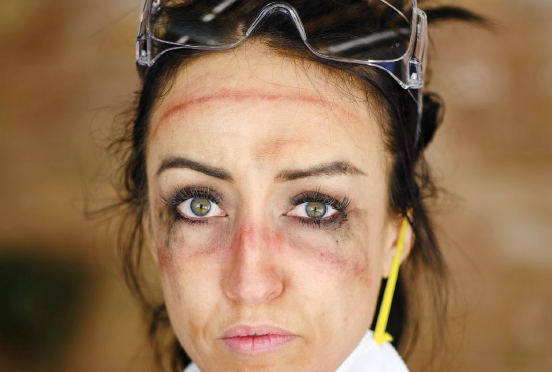A 55-year-old male presenting with acute abdominal pain, an 11-year-old female with a twisted ankle, a 90-year-old male complaining of shortness of breath. What do all these people have in common? They are all ED patients with COVID-19.
After months of working on the front lines, attendings, residents, and medical students are all familiar with the routines of the COVID-19 pandemic. With each patient encounter, the once familiar setting of sitting down at eye level with patients and taking the time to build rapport has been replaced by a new routine: layers of PPE and a sense of urgency to provide rapid and effective care to COVID-19 positive patients, while limiting the exposure of all workers in the emergency department. Despite attempts to optimize patient and staff safety, exposure to symptomatic and asymptomatic patients with COVID-19 is inevitable.
Medical students, limited by hospitals and medical schools, are frequently prohibited from seeing suspected or confirmed COVID-19 patients. Despite these restrictions, exposure may still occur and comes at the cost of the medical student’s education and ability to meet academic requirements. Residents, whether they be new interns or upper levels, are typically the first providers to see these infected patients. Juggling the weight of their responsibilities as new doctors alongside learning to care for critically sick patients, residents consistently question and examine their efforts and depth of knowledge in providing effective patient care. Attending physicians support the residents, medical students, and patients. Regardless of personal hindrances, they must display strength, knowledge, and tenacity to propel their team forward in the care of patients with COVID-19. Regardless of each individual’s role in the Emergency Department, the underlying threat is the risk of exposure and the fear that contracting COVID-19 may impose imminent danger to one’s immediate family and friends. Whether we consciously or subconsciously recognize these fears, the negative impact of COVID-19 on our mental health is undeniable.
Post Traumatic Stress Disorder (PTSD) is commonly associated with victims of combat and trauma. With the upsurge of emotional turmoil and strife associated with the COVID-19 pandemic, PTSD has now become a prominent and pressing issue among healthcare workers. Post Traumatic Stress Disorder is defined as “persistent, distorted cognitions about the cause or consequences of the traumatic event(s) that lead the individual to blame himself/herself or others.”1 Diagnostic criteria include “negative alterations in cognition and mood associated with the traumatic event(s)” and “marked alterations in arousal and reactivity.” While these manifestations may be subtle, variation in sleeping habits, increased irritability, problems with concentration, and hypervigilance can all suggest PTSD. What may seem to be a normal conversation in the ED break room regarding exhaustion and sleeping difficulty may be a red flag that a coworker is struggling with their mental health.
During the early peak of the pandemic in late March to early April of 2020, Norway3 conducted a study on the prevalence of PTSD, depression, and anxiety in healthcare workers. They conducted a cross-sectional survey from 1,773 healthcare workers and public service providers throughout Norway from March 31 - April 7, 2020, using a checklist of questions to screen for psychiatric manifestations. Of all individuals surveyed, 28.9% of that population was found to have clinical or subclinical PTSD symptoms. Out of that group, 36.5% of individuals were known to be working directly with COVID-19 patients. A similar study4 was done surveying 97,333 healthcare workers across 21 countries for symptoms of depression, anxiety, and PTSD. Among the data collected, the prevalence of moderate PTSD was found to be 21.5% with individual study estimates ranging from 2.9% to 49%. Despite the variation in numerical data, it is evident that signs and symptoms of PTSD are a pervasive issue among healthcare workers facing the COVID-19 pandemic regardless of geographic location.
The manifestations of PTSD may vary in symptoms and severity. While there are no strictly defined methods to prevent PTSD, certain protective factors have been identified. Utilizing an online survey2 of 1,092 healthcare workers specifically in high COVID-19 infection rate locations, Hennein et al. explored the various socio-ecological predictors that impacted their mental health outcomes. Of the various components assessed, the only definitive protective factor against developing PTSD was an increased perception of team cohesion. Team unity in the ED has the power to combat mental illness and can be readily employed by all members of the healthcare team.
Working in the ED during the COVID-19 pandemic, there will always be an underlying fear and uncertainty as to what we will encounter at any point during our shift. Whether it be COVID-19, a new variant of the virus, a needlestick injury, or another pathogen entirely, the risks we face while serving in the emergency department are a reality that must be faced. While PPE and isolation protocol are vital to staff and patient safety, it is also just as important to protect our mental wellness. The psychological impacts of this pandemic will evidently weigh on many healthcare workers' lives for years to come, but the way we choose to respond and care for one another will have the most lasting impact.
References
- American Psychiatric Association. Diagnostic and statistical manual of mental disorders. 5th ed. 201
- Hennein R, Mew EJ, Lowe SR. Socio-ecological predictors of mental health outcomes among healthcare workers during the COVID-19 pandemic in the United States. PloS one. 2021;16(2):
- Johnson SU, Ebrahimi OV, Hoffart A. (2020). PTSD symptoms among health workers and public service providers during the COVID-19 outbreak. PloS one. 2020;15(10):
- Li Y, Scherer N, Felix L, Kuper Prevalence of depression, anxiety and post-traumatic stress disorder in health care workers during the COVID-19 pandemic: A systematic review and meta-analysis. PloS one. 2021;16(3):e0246454.



